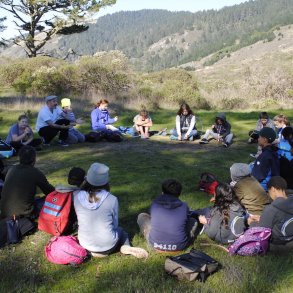Some people think that self-managing workplaces are only a good fit for a certain type of person. Or that you need to be operating above a certain “level of consciousness” in order to be ready for it.
I think this is hogwash. Our team of 20 has been working without bosses for nearly four years, and we’ve only had two people who couldn’t handle Fitzii’s governing principle of Radical Freedom & Responsibility.
That’s not to say that it’s easy to transition into self-management. It’s emotionally difficult because it forces you to inspect your own ego, fears, and motivations, as you are constantly subjected to feedback and advice which shines a light on your impact on other people and the business.
You can’t hide from the truth in a self-managing environment.
And the truth is what unleashes your potential to do your most meaningful work, as well as grow and connect with your co-workers like you never have before.
We’ve noticed that people’s adoption of self-management is more like a journey than an event. It seems to generally follow three stages, which can take anywhere from a few months, to a few years, to get through.
The Three Stages of Self-Management Adoption
1 – The HEAD (intellectual stage)
Understanding: The “Teal” paradigm of self-management where the organization is an ecosystem, and people are trusted, is very different than most organization’s “Orange” paradigm where the organization is a machine, and humans are resources to be managed. Some people may have come from the “Green” paradigm where the organization is more like a family hierarchy (like B Corps), and all stakeholders (employees, shareholders, customers, community, etc) should benefit. The key here is to understand how self-management is fundamentally different than other organizational paradigms.
Action: Once people understand and willingly accept the expectations of self-management, they lean-in and proactively learn about and experiment with these new practices. Initially that often means giving and receiving feedback, and participating in an advice process, Generative Decision Making (GDM), and various psychological safety, teaming and meeting practices.
Transformation: After understanding the principles of self-management, and then experiencing how practices have been crafted to deliver exceptional growth, fulfillment, connection and productivity, the newbie is sold. They “get it” – meaning they believe in the power and effectiveness of self-management for both personal and organizational development.
2 – The HEART (emotional stage)
Understanding: Self-management requires a constant, honest and emotionally difficult look at your self in order to serve the team. This paradigm views the organization as an ecosystem which has an evolutionary purpose, and strives for maximum overall health through applying collective intelligence and sense-making. Therefore, each person in the ecosystem also must do the same by seeking out feedback and then getting in touch with their own emotional health, purpose, and yearning for growth.
Action: Once someone understands that self-management is a commitment of self-awareness, introspection, and personal growth, and they feel safe and supported by their colleagues, they begin to proactively seek experiences that expose their deepest desires and fears. Seen through this lens, the most emotionally difficult practices, like our Role Advice Process, Compensation Advice Process, Finding your Why, and the Conflict Resolution Practice, are terrific opportunities for major realizations, and massive growth spurts.
Transformation: After experiencing one or more major emotional realizations (usually tears are involved), the individual connects with their purpose and growth path. This provides emotional strength and changes their orientation from being primarily focused on their own needs, to serving the needs of the team (of which their needs are a key part).
3 – The HABITS (behavioural stage)
Understanding: Intellectually and emotionally connecting with the paradigm of self-management is not enough to be the person you want to be. Identity and behavioural change come from the deliberate practice of new habits. Many of your old habits were formed in a different paradigm, and old habits die hard. The key understanding of this final stage is of the need for vulnerability-based leadership, conscious behaviour change, and public accountability.
Action: The typical growth path is to declare the root of your fear-based actions, and publicly work on habit change by asking for feedback and support when you are hijacked by your ego or have succumbed to a negative self-talk spiral. It’s key to become increasingly mindful of these negative loops and reduce the time it takes to catch and transform them into positive thoughts, actions, and feelings.
Transformation: The work of this final stage is a never-ending hero’s journey of discovery, challenge, and growth in forming more effective ways of thinking, feeling and behaving. At points there may be need for reinvention, as “what got you here, won’t get you there”. The transformation is relatively constant, but non-linear. People experience big leaps and perhaps even some backward steps, as they face up to deeply personal questions and existential challenges.
—
While we do have broad agreement within Fitzii that these three stages are generally true and consistent, there is a lot of variation of experience within each stage, and each person’s experience has been unique.
For people curious about personal experiences, we’ve polled the team to answer two questions about their adoption into self-management. Enjoy!
What’s been the hardest thing about transitioning into self-management?
Vulnerability. The thing that keeps you from being your most productive is often a character flaw, or at least it was for me, and working through that was more public than I would have preferred. And… it may have been part of the remedy that’s helped me to get a handle on it quicker. -James, Product Development
Coming from a role where I managed a team of people made it difficult to transition. I wondered how I would lead, how I could help others, and how I would grow. After being in a Teal environment for 1.5 years, I’ve realized that you can still lead and support others with their growth. Leaders must adopt and embody the principles of self-management themselves, so others can embrace these principals as well. -Anisa, Hiring Success
The most challenging thing has been the aspect of determining what “success” looks like in a Teal environment. Throughout the past year, I’ve learned that “success” is not only numbers. We celebrate successes through value, contribution and impact. -Lori, Business Development
Giving consistent and meaningful tough feedback. I am a natural cheerleader and coach so giving positive feedback came second nature. However, I am someone who is very sensitive to people’s feelings and giving tough feedback was initially excruciating for me. Once I truly understood that giving constructive feedback is all about caring for and caring about the person you are delivering it to, I suddenly became very adept at the process. It just took time to master this skill. -Katherine, Business Development
I didn’t particularly struggle with the idea of self-management coming from a self-employed background. That said, I have come to understand self-management as not referring only to myself, but rather managing myself in the context of the group – that’s been very challenging. -Jeremy, Recruitment
The hardest transition that I had to do, was to learn the difference between self-management and being a boss. My instinct has always been to walk into a crowd and lead a group the way I wanted something done. In our environment, there is no such thing as a boss or ONE leader. Instead, we trust and depend on each other to get the work done, be the best versions of ourselves and continue to self-manage ourselves the way we know how. -Kori, Recruitment
My biggest fear prior to working in a self-managed environment was about not knowing who to turn to for support, general guidance, or questions. Once I came into it, I had a Teal sponsor and work buddy to help guide me, plus so many different subject matter experts within the organization. With the sponsorship program and consistent guidance throughout, it became very easy to navigate who I can lean on for support. -Jennifer, Hiring Success
Overall the transition has been one of both my heart and mind. Typically, in starting a new role and joining a new team if you can get the mind part you can embrace the heart after or vice versa. However, in self-management there seems to be a need to get up to speed on both fronts faster and more earnestly. When you are working in a more ‘typical’ environment sometimes the accountability is only seen as one direction, UP. In self management it goes every which way; up, down, internally and all around. This creates a higher level of transparency and at times this can move you along faster than you expected (both your heart and your mind) and the emotions you feel at times may be overwhelming. This is a great experience but does not come without a challenge and transition. -Shannon, Business Development
Coming from a large Orange organization made it difficult for me to bring my whole self to work. I just wasn’t used to being fully transparent about my interests, wants and needs. Questions that often came up in my mind were, “am I going to be judged for being myself”, “what if they don’t think I’m a fit?” and lastly “what if they don’t take me seriously?” Fitzii has a safe and healthy work environment. There’s room for storytelling practices, meaningful conversations, self decorated spaces and no titles or status markers to define people’s roles. This made it easy for me really start bringing my whole self to work. -AH, Hiring Success
What advice would you give to a new Fitzii employee about balancing Radical Freedom & Responsibility?
Welcome to a world you’re not used to and an environment you’ve never been in. You’ll have the freedom to do as you wish but realize that whatever you choose to do, will have an outcome and an effect on the rest of the team. Balancing Radical Freedom & Responsibility means that after time, you instinctively and naturally think about your team before you take a day off or work from home. Eventually, you’ll put others before yourself in a positive way. Radical Freedom & Responsibility is an amazing feeling and you’ll embrace it in no time! -Kori, Recruitment
Don’t be afraid to ask questions, and ask for help or support! It’s your responsibility to take the initiative to be transparent about your feelings and thoughts. Everyone is happy to help and wants to see you grow and succeed! -Jennifer, Hiring Success
Be very honest with yourself about which one you are likely to find easier [between Radical Freedom & Responsibility] and lean into helping others who struggle with that one. Then make efforts or get help from someone who’s better at the one you find tougher. -James, Product Development
Speak up. When you have feedback or advice, it’s important to provide this information in a constructive way (all of which we’ll teach you about). Everyone has a voice in a teal organization, and it’s your responsibility to maximize your contribution towards our purpose. -Anisa, Hiring Success
I would suggest that new employees take a moment to reflect on how accountable they are for their actions in their daily lives and then imagine amplifying their assessment. You are forced to raise your game along with all those around you. -Jeremy, Recruitment
I would say embrace it! With a great deal of freedom, it means you have to create more responsibility and accountability for yourself… so try to realise that and don’t shy away from hearing when you are getting it wrong (or RIGHT). Celebrate both experiences. The great thing about creating freedom for yourself is that is gives you the gift of being more responsible for those things you take on. This has been a true gift for me and I am excited to see what comes with it in the coming years and months. -Shannon, Business Development
Republished with permission.
Featured Image/graphic link and block quoting added by Enlivening Edge Magazine




